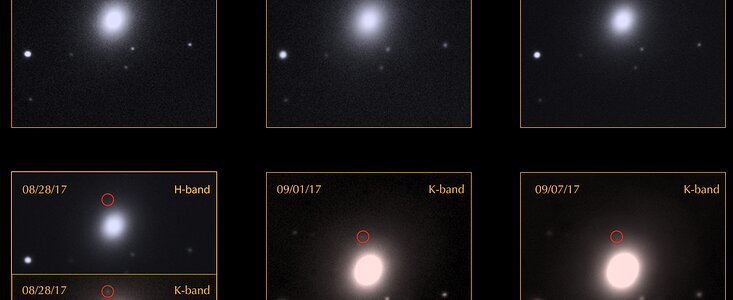Media Advisory: Science Writer’s Workshop on Multi-Messenger and Time-Domain Astronomy
Journalists are invited to a special workshop at the 237th meeting of the American Astronomical Society
17 December 2020
On Friday 8 January 2021 journalists and other communications professionals are invited to participate in a virtual workshop on multi-messenger and time-domain astronomy. The workshop is part of the 237th meeting of the American Astronomical Society (AAS) and will run from 12:00 pm to 4:00 pm EST (17:00 to 21:00 GMT) [1].
Featuring presentations by several leaders in the fields of multi-messenger and time-domain astronomy, the workshop is offered jointly by NSF’s NOIRLab and the AAS Press Office. Funding is provided by the National Science Foundation through the Gemini Observatory’s Gemini in the Era of Multi-Messenger Astronomy program (GEMMA).
Advance registration with an AAS 237 press registration is required by Wednesday 6 January 2021 (press registration is open to bona fide working journalists, public information officers, and other science writers).
Over the past decade or so, discoveries have been made with “messengers” from space that go beyond photons, the messenger of light: particles from distant galaxies, neutrinos from the Sun and supernovae, and most recently ripples in the fabric of spacetime itself, known as gravitational waves. At the same time, a growing realization of the importance of the Universe’s dynamic nature has crept into astronomy: supernovae explode, stars change in brightness, novae flare, and outbursts occur in regions around black holes. Multi-messenger and time-domain astronomy are two of the most rapidly advancing areas of astronomy, and it is expected that over the next decade and beyond these disciplines will define modern astronomy.
The key objective of the workshop is to provide a glimpse into the future of multi-messenger and time-domain astronomy and the facilities that will drive these fields. Additionally, there will be a discussion about the challenges of communicating multi-messenger and time-domain astronomy in the context of the forthcoming white paper on best practices in large-scale, multi-institutional communication in the field.
Featured speakers:
- Martin Still, National Science Foundation: Welcome from NSF
- Jennifer Lotz, Director Gemini Observatory, NSF’s NOIRLab: Multi-messenger and Time-domain Astronomy and the Role of Gemini and GEMMA
- David Reitze, Executive Director LIGO Observatory: LIGO and its Historical and Future Role in Multi-messenger and Gravitational Wave Science
- Federica Bianco, Professor of Physics and Astronomy & Public Policy and Administration, University Delaware, Rubin Observatory: Vera C. Rubin Observatory: Ushering a New Era of Time-domain Astronomy
- Lisa Storrie-Lombard, Director Las Cumbres Observatory: The AEON Network and Multi-messenger and Time-domain Astronomy
- Jessica Dempsey, Deputy Director East Asian Observatory: Event Horizon Telescope and Communications With Large, Multi-institutional Collaborations — Lessons Learned
- Whitney Clavin, Senior Content and Media Strategist, Caltech, and Peter Michaud, Education & Engagement Manager, NSF’s NOIRLab: Best Practices for Large Scientific Collaborations — White Paper Discussion
Notes
[1] 10 am MST or 2:00 pm CLST.
More information
NSF’s NOIRLab (National Optical-Infrared Astronomy Research Laboratory), the US center for ground-based optical-infrared astronomy, operates the international Gemini Observatory (a facility of NSF, NRC–Canada, ANID–Chile, MCTIC–Brazil, MINCyT–Argentina, and KASI–Republic of Korea), Kitt Peak National Observatory (KPNO), Cerro Tololo Inter-American Observatory (CTIO), the Community Science and Data Center (CSDC), and Vera C. Rubin Observatory. It is managed by the Association of Universities for Research in Astronomy (AURA) under a cooperative agreement with NSF and is headquartered in Tucson, Arizona. The astronomical community is honored to have the opportunity to conduct astronomical research on Iolkam Du’ag (Kitt Peak) in Arizona, on Maunakea in Hawaiʻi, and on Cerro Tololo and Cerro Pachón in Chile. We recognize and acknowledge the very significant cultural role and reverence that these sites have to the Tohono O'odham Nation, to the Native Hawaiian community, and to the local communities in Chile, respectively.
The American Astronomical Society (AAS), established in 1899, is the major organization of professional astronomers in North America. Its membership (approx. 8,000) also includes physicists, mathematicians, geologists, engineers, and others whose research interests lie within the broad spectrum of subjects now comprising the astronomical sciences. The mission of the American Astronomical Society is to enhance and share humanity’s scientific understanding of the universe, which it achieves through publishing, meeting organization, science advocacy, education and outreach, and training and professional development.
Links
Contacts
Peter Michaud
Education & Engagement Manager
NSF’s NOIRLab
Cell: +1-808-936-6643
Email: peter.michaud@noirlab.edu
Rick Fienberg
AAS Press Officer
Cell: +1-857-891-5649
Email: rick.fienberg@aas.org


